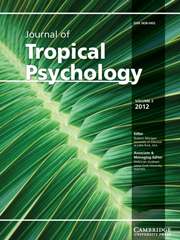Crossref Citations
This article has been cited by the following publications. This list is generated based on data provided by
Crossref.
Cichocka, Aleksandra
Marchlewska, Marta
Golec de Zavala, Agnieszka
and
Olechowski, Mateusz
2016.
‘They will not control us’: Ingroup positivity and belief in intergroup conspiracies.
British Journal of Psychology,
Vol. 107,
Issue. 3,
p.
556.
Mashuri, Ali
Akhrani, Lusy Asa
and
Zaduqisti, Esti
2016.
You are the real terrorist and we are just your puppet: Using individual and group factors to explain Indonesian muslims’ attributions of causes of terrorism.
Europe’s Journal of Psychology,
Vol. 12,
Issue. 1,
p.
68.
Mohamed, Ahmed Ezzeldin
2017.
Believing Conspiracy Theories : Causes, Effects and Processes from a Comparative Empirical Perspective.
SSRN Electronic Journal ,
Stojanov, Ana
and
Halberstadt, Jamin
2019.
The Conspiracy Mentality Scale.
Social Psychology,
Vol. 50,
Issue. 4,
p.
215.
Pierre, Joseph M.
2020.
Mistrust and misinformation: A two-component, socio-epistemic model of belief in conspiracy theories.
Journal of Social and Political Psychology,
Vol. 8,
Issue. 2,
p.
617.
Prandi, Lorenzo
and
Primiero, Giuseppe
2020.
Effects of misinformation diffusion during a pandemic.
Applied Network Science,
Vol. 5,
Issue. 1,
Bertin, Paul
and
Delouvée, Sylvain
2021.
Affected more than infected: The relationship between national narcissism and Zika conspiracy beliefs is mediated by exclusive victimhood about the Zika outbreak.
Journal of Pacific Rim Psychology,
Vol. 15,
Issue. ,
Naseralla, Eyad J.
Baker, S. Glenn
and
Warner, Ruth H.
2021.
The influence of political partisanship on perceptions of sexual assault.
Analyses of Social Issues and Public Policy,
Vol. 21,
Issue. 1,
p.
210.
2022.
The Cambridge Handbook of Political Psychology.
p.
361.
Farhart, Christina E.
2022.
The Cambridge Handbook of Political Psychology.
p.
526.
Czech, Franciszek
2022.
Links Between Conspiracy Thinking and Attitudes Toward Democracy and Religion: Survey Data From Poland.
Politics and Governance,
Vol. 10,
Issue. 4,
Prandi, Lorenzo
and
Primiero, Giuseppe
2022.
A logic for biassed information diffusion by paranoid agents in social networks.
Journal of Logic and Computation,
Vol. 32,
Issue. 6,
p.
1292.
Mashuri, Ali
and
Osteen, Chad
2023.
Threat by Association, Islamic Puritanism and Conspiracy Beliefs Explain A Religious Majority Group’s Collective Protest Against Religious Minority Groups.
Psychology and Developing Societies,
Vol. 35,
Issue. 1,
p.
169.
Frenken, Marius
and
Imhoff, Roland
2023.
Don't trust anybody: Conspiracy mentality and the detection of facial trustworthiness cues.
Applied Cognitive Psychology,
Vol. 37,
Issue. 2,
p.
256.
Adam‐Troian, Jais
and
Bélanger, Jocelyn J.
2024.
“Consumed by creed”: Obsessive‐compulsive symptoms underpin ideological obsession and support for political violence.
Aggressive Behavior,
Vol. 50,
Issue. 1,
Filindra, Alexandra
Kaplan, Noah J.
and
Manning, Andrea
2024.
Who Buys the “Big Lie”? White Racial Grievance and Confidence in the Fairness of American Elections.
The Journal of Race, Ethnicity, and Politics,
Vol. 9,
Issue. 1,
p.
182.
Borinca, Islam
Guerra, Rita
and
Uka, Fitim
2025.
“Ins and outs”: Ethnic identity, the need to belong, and responses to inclusion and exclusion in inclusive common ingroups.
Group Processes & Intergroup Relations,
Vol. 28,
Issue. 2,
p.
324.
Toribio‐Flórez, Daniel
Altenmüller, Marlene S.
Douglas, Karen M.
Gollwitzer, Mario
Adinugroho, Indro
Alfano, Mark
Apriliawati, Denisa
Azevedo, Flavio
Betsch, Cornelia
Białobrzeska, Olga
Bret, Amélie
Valdez, André Calero
Cologna, Viktoria
Czarnek, Gabriela
Delouvée, Sylvain
Doell, Kimberly C.
Dohle, Simone
Dubrov, Dmitrii
Dzimińska, Małgorzata
Elbaek, Christian T.
Facciani, Matthew
Fage‐Butler, Antoinette
Ferreira, Marinus
Friese, Malte
Fuglsang, Simon
Gallyamova, Albina
Garrido‐Vásquez, Patricia
Vásquez, Mauricio E. Garrido
Genschow, Oliver
Ghasemi, Omid
Gkinopoulos, Theofilos
Brambila, Claudia González
Gordon, Hazel Clare
Grigoryev, Dmitry
Hernández‐Mondragón, Alma Cristal
Jin, Tao
Jungkunz, Sebastian
Jurgiel, Dominika
Kerr, John R.
Kojan, Lilian
Komyaginskaya, Elizaveta
Lamm, Claus
Légal, Jean‐Baptiste
Levy, Neil
Marques, Mathew D.
Mayer, Sabrina J.
Mede, Niels G.
Milfont, Taciano L.
Mitkidis, Panagiotis
Nitschke, Jonas P.
Paruzel‐Czachura, Mariola
Parzuchowski, Michal
Pronizius, Ekaterina
Pypno‐Blajda, Katarzyna
Rêgo, Gabriel Gaudencio
Ross, Robert M.
Schmid, Philipp
Stanley, Samantha K.
Syropoulos, Stylianos
Szumowska, Ewa
Teran‐Escobar, Claudia
Todorova, Boryana
Vilares, Iris
Warwas, Izabela
Weber, Marcel
Westfal, Mareike
and
Wojcik, Adrian Dominik
2025.
Victims of Conspiracies? An Examination of the Relationship Between Conspiracy Beliefs and Dispositional Individual Victimhood.
European Journal of Social Psychology,
Sharma, Shruti
Shahnawaz, Mohammad Ghazi
and
Zafar, Maria
2025.
Determinants and consequences of belief in Islamophobic conspiracy theories among youth in India.
Asian Journal of Social Psychology,
Vol. 28,
Issue. 4,
Galbraith, Deane
2025.
Ngāti Hotu in Paradise: How Contemporary Hotu in Aotearoa New Zealand Defend their White Pre-Polynesian Settlement Theory.
Journal of the Bible and its Reception,
Vol. 12,
Issue. 1,
p.
133.

